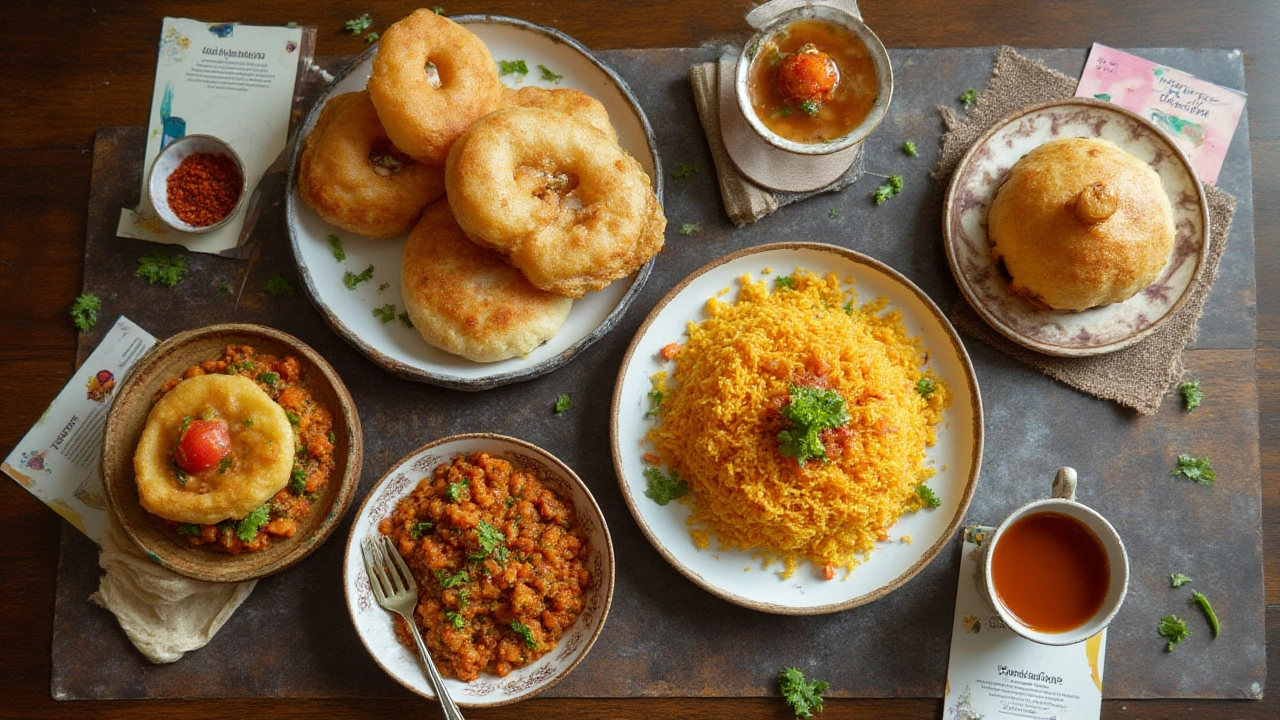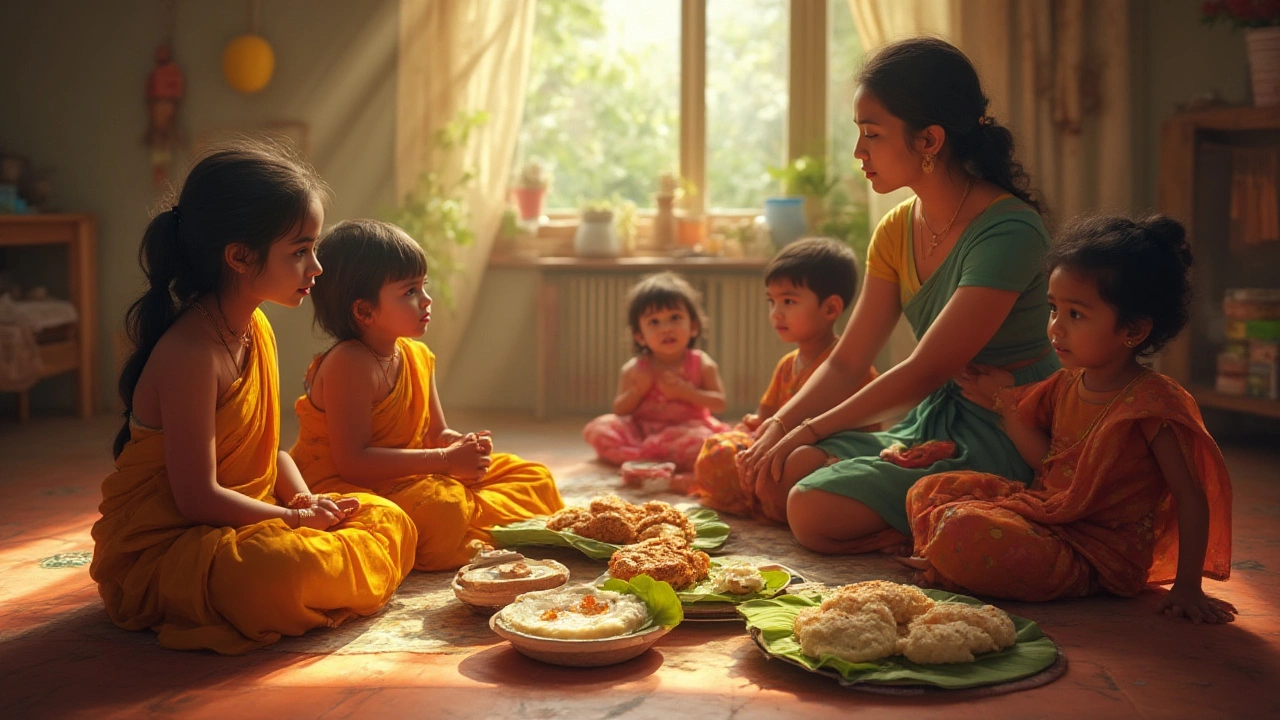If you thought Indian breakfast is just chai and parathas, you’re barely scratching the surface. Walk through any Indian neighborhood on a busy morning, and you’ll pick up more breakfast scents than you can count: sizzling spices, fresh bread, fermented rice, and, sometimes, that unmistakable hint of melted ghee. In this country, breakfast isn’t just the first meal—it’s practically a celebration. Sometimes, the only thing louder than the honking autos outside is the sizzle from the kitchen.
The Diversity of Indian Breakfasts: North to South and Beyond
Breakfast in India doesn’t fit in a neat box. It changes dramatically depending on where you are. In the north, you’ll bump into buttery parathas—often stuffed with potatoes, cauliflower, or even paneer. These flatbreads aren’t just food; they’re family legends, usually served hot with a spoonful of tangy pickle and a bowl of fresh curd. Move just a bit east, and you might find kachoris, which are deep-fried and stuffed delicacies, or soft, puffed puris paired with spicy potato curry. Head to Punjab, and be ready for the king-sized aloo paratha, where dollops of butter rule supreme. I actually come from a Punjabi background, and trust me, saying no to another paratha at grandma’s is close to a crime.
But let’s talk about the South. Here, hands get messy with fluffy idlis and crispy dosas. Both made from fermented rice and lentils, but that’s where the similarities end. Idlis are soft, cloud-like cakes, often paired with coconut chutney and a warm bowl of sambhar—a spicy lentil and vegetable stew. Dosas feel like the opposite: thin, crisp, and usually stuffed with masala potatoes. You eat these at home, at roadside stalls, or even grab them on an express train. Karnataka’s breakfast star is bisibele bath, a kind of comforting, soupy rice packed with lentils, veggies, and a burst of traditional spices. Andhra’s upma is equally beloved—think of it as a savory, fluffy porridge loaded with peanuts, ginger, and curry leaves.
The east and west bring their own magic. In Bengal, the first meal is often luchi (puffed white breads) with cholar dal (chana dal cooked with sweet-spicy coconut and whole spices). In Gujarat, the day starts with dhokla, a steamed snack made from fermented lentil and rice batter that’s light, tangy, and always in demand. Maharashtra serves everything from poha (flattened rice wok-tossed with turmeric, mustard seeds, onions, green peas, and lemon) to misal pav—a spicy curry topped with crunchy sev and served with buttered bread rolls. You can see why picking a favorite is basically impossible.
Honestly, Indian breakfast is as much about tradition as it is about taste. Different religions and communities add even more flavor. Many Jain families avoid onions and garlic, and you’ll find unique Jain versions of classic dishes. In Kerala, where the breakfast table feels like a real feast, you might find appam (rice pancakes with lacy, crispy edges), puttu (steamed rice cakes layered with coconut), or idiappam (rice noodle cakes).
Check most urban Indian kitchens, and there’s no set time for breakfast. Office-goers might down their poha in seven minutes flat, while kids fuss over the right amount of ghee on toast. But one constant: breakfast has to taste like home.
| Region | Popular Breakfast Dish | Main Ingredients |
|---|---|---|
| North | Paratha | Wheat flour, vegetables, spices, butter |
| South | Idli/Dosa | Rice, lentils, coconut, spices |
| West | Poha | Flattened rice, onions, potatoes, peanuts |
| East | Luchi-Cholar Dal | Refined flour, chana dal, coconut |

Breakfast Favorites and How They're Enjoyed at Home
Nothing gets families out of bed faster than breakfast on the table. Even Zoya, my over-enthusiastic dog, gets a sniff of hot chapatis or a pat of ghee, and she’s beside herself. In most Indian homes, cooking breakfast is serious business. Sure, you have cereal and bread, but the day feels incomplete unless there’s something warm, fragrant, and slightly labor-intensive.
Let’s break down some loved dishes. Parathas often steal the show in the north. They start off simple but end in a flurry of activity: kneading dough, rolling it flat, stuffing it with seasoned potatoes or cauliflower, then crisping it on a tawa with lots of ghee or butter. These aren’t just eaten; they’re devoured, with yogurt and pickles on the side for that explosion of flavors.
South Indian homes often prepare idli or dosa batter overnight (or keep a backup batch). Come morning, there’s always an argument about who gets the first dosa, and everyone wants the golden, crisp one. Chutneys—often at least two kinds, coconut and tomato—are served alongside. Sometimes, leftovers from dinner become breakfast. Rice from last night transforms into lemon rice or curd rice, served cold on blistering days. Some families swear by their own favorite combinations. For example, my Tamilian friend can’t imagine idli without podi (spicy chutney powder mixed with sesame oil).
Not everything is elaborate, though. You’ll find poha being thrown together quickly in the west. All you need is flattened rice, a quick fry with mustard seeds, curry leaves, onions, and a squeeze of lime, and breakfast is ready. This dish is legendary for its speed and flavor, especially during rushed school mornings. Likewise, upma—semolina roasted with veggies and nuts—gets breakfast on the table super-fast.
In coastal areas, breakfast often includes seafood. Goan households might eat poi (local bread) with spicy prawns or sardines. Rural homes sometimes keep it even simpler: a bowl of steaming dal with freshly cooked rice, or bajra rotis with chutney. Urban folks, always on the go, might settle for a cup of sweet, milky tea (chai), a couple of biscuits, or toast slathered in tangy fruit jam.
What’s really fascinating is how breakfast adapts to local produce and changing habits. With the rise of health-conscious living, more families are adding things like oats and millet pancakes (ragi or bajra) to the mix. You’ll see more vegan and gluten-free twists on classic dishes, especially in metro cities like Mumbai and Bangalore.
If you’re trying to bring Indian breakfast home, you don’t need to go fancy. Start with poha or upma—they need basic spices, and both take less than 20 minutes. Want something richer? Try making parathas but don’t skimp on the butter (there’s a reason it’s called makhan in Punjabi homes). If you love crispy food, dosa is your best bet—though the batter needs to ferment overnight if you want the real deal.
- Indian breakfast isn’t just any meal—it’s comfort, nostalgia, and community rolled into one big, fragrant plate.
- Taste changes city to city, and even between households.
- You’ll find healthy and hearty options in every state—never boring, never bland.

Surprising Facts, Regional Rituals, and Breakfast Tips
If you love trivia, Indian breakfast won’t disappoint. For one, some locals swear that eating spicy pickles with your paratha in the morning will boost your metabolism. In big cities, office cafeterias sell thousands of idlis or vada pavs a day. One Chennai train station can serve over 40,000 idlis before 10 am! In rural Rajasthan, bajra rotis are steamed over cow dung fires for maximum flavor—this earthy method is centuries old.
Breakfast timing varies widely. Students in cities might grab a quick bite at 7 am. Farmers in Tamil Nadu, working before the sun’s up, eat kanji (rice gruel) by 6 am. Older folks can take their time with tea and the newspaper, especially on weekends. Festivals bring even more feast-worthy items to the table: puran poli (sweet flatbread with lentil filling) in Maharashtra, or sheera (semolina pudding) for auspicious occasions in Gujarat.
How to make your breakfast more like India? Here are tips straight from desi kitchens:
- Spice is life: Even a tiny bit of chopped green chili or fresh ginger can turn an average toast into a fiery, flavorful bite.
- Chutneys are your friend: Don’t settle for just ketchup—try making coconut, mint, or peanut chutney on the side.
- Ferment your batter: The unique taste of dosa and idli comes from overnight fermentation. Warm spots are best for the batter to rise.
- Balance nutrition: The best Indian breakfasts combine carbs, proteins, and veggies in every plate.
- Don’t fear ghee or butter: A bit adds magic flavor, and, as my grandmother would say, "It keeps you young at heart."
- Repurpose leftovers: Last night’s dal can become the base for a savory pancake batter, or yesterday’s rice gets a second life as lemon rice.
- Try local grains: Switch up wheat for millets or rice for something less processed. Your gut—and your taste buds—will thank you.
Here’s another fun fact: according to a recent survey (conducted by a major breakfast cereal company), 63% of urban Indian families still prefer homemade dishes to packaged foods in the morning, citing comfort and flavor as the top reasons.
So next time you wake up craving something special, sneak into the world of Indian breakfasts. You’ll forget about boring cereal bowls—promise.
